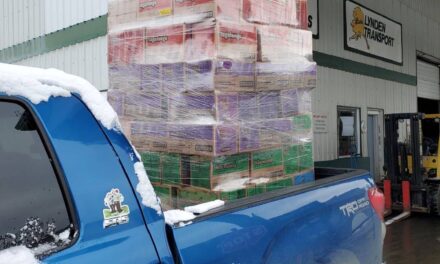
Workers test for residual fluid in a section of pipeline at the former fuel terminal. The Army is removing all 15,000 linear feet of pipeline at the fuel terminal as part of the effort to address the long-standing contamination there. (Emily Files)
Extensive testing at the former Haines Tank Farm and Fuel Terminal found widespread fuel-related contamination. Approximately 75,000 cubic yards of soil have contaminants that exceed environmental standards.
The problem is decades old, from the time that the Haines-Fairbanks pipeline operated with little environmental oversight in the 1950s and ‘60s. This contamination investigation will hopefully lead to a final clean-up. But at a meeting last week, some residents said the process was not moving fast enough.
Thursday’s restoration advisory board meeting took a different tone than the last. Almost immediately, members confronted a presenter about what they saw as too-slow progress.
“This is poppycock,” said Jim Studley. “You are not taking advantage of the situation. The inability of the government to act is ridiculous.”
The suggestion that opened the floodgates of criticism came from Army Corps of Engineers representative Beth Astley. Astley was reviewing the contamination found at two sites along the pipeline (outside of the fuel terminal) at about 15 and 23 Mile of the Haines Highway. She suggested one solution to dealing with the contamination at 23 Mile may be to cap it as part of the planned state highway improvement project.
But Studley said the contamination needs to be removed, not capped.
“We have to follow the rules,” Astley said. “It’s not always the most efficient process, I’ll admit that. But we are doing this the right way.”
“No you’re not, you’re doing it the stupid way,” Studley responded. “It might be outlined in law, but it’s not the right way.”
Bill Kurz made a motion that the board recommend the Corps clean up the area instead of capping it. At first some members said it was premature to advise that kind of action, but eventually, they voted unanimously for it.
The site that drew the greatest negative response from the advisory board was the least contaminated area under investigation. The most contaminated is the former tank farm and fuel terminal. The Army owns the site, and its contractors drilled hundreds of testing holes throughout the 80-acre area last year.

The former Haines Fuel Terminal. (Emily Files)
“We are looking for the nature and extent of any contamination. What is it, how far does it go out?” said Arden Bailey, who works for NorthWind Inc., the company that’s conducting much of the research.
The results of the testing show contamination in the soil and groundwater at numerous locations around the property. They include all but one of the 13 fuel tanks, the administration area, the beach across the road from the admin area, the Lutak burn pit and the Manifold building.
Most of the contamination is gas and diesel-range organics and benzene. In other words, contamination related to fuel leaks or spills.
But one section, the drum storage area, had a different kind of contamination: chlorinated solvents.
“That’s the only contamination we had that wasn’t associated with fuel-type contamination,” Bailey said. “So it’s a basically a cleaning solvent. So it’s a solvent that was used for de-greasing, cleaning things for maintenance.”

A sign at a beach across from the fuel terminal warns of potential contamination. (Emily Files)
Bailey says NorthWind will conduct more testing in that area. They’ll also drill a few more holes and take additional groundwater samples.
After the investigation is done, the next step is to draw up a risk assessment. That will put on paper what hazards the contamination poses to the environment, humans, wildlife and more. After that, there will be a feasibility study examining what the options are to finally deal with the contamination.
The sentiment at the board meeting was that step can’t come soon enough. But the Army says it’s probably about two years off.










As with most environmental cleanups, the cleanup itself is not as complicated as building a consensus as to how and who’s to perform the cleanup. The basic elements necessary to perform the cleanup are already at the site. The indigenous bacteria in the soil if properly managed will consume the residual fuels and solvents without the need or the expense of moving the polluted soil to another location to be further managed.
The environmental industry prefers to perform lots of studies before any cleanup takes place. This maximizes the profitably of those performing the site’s assessment but excessive site assessment does little more than deplete the funds available for actual cleanup. The contaminant mass and its location at the Haines Terminal site are well documented, why not start cleanup there and work out until the outside of the pollutant envelope has been reached?
Or you could further delay cleanup in favor of performing additional studies and fill up hundreds of pages of reports with graphs, charts and tables that tell you what you already know, the site’s polluted and needs to be cleaned up.
It is heartbreaking this is still dragging on. I grew up on the Tank Farm, my Father ran the Lab. I have many memories of him complaining about spills…and memories of him using that cleaning solvent (I’d take lunch to him in the Lab). Our 3 folks in Congress should get engaged in moving remediation forward.
The Governor’s Office should demand action! This has been unresolved far too long!